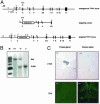Disruption of the nonneuronal tph1 gene demonstrates the importance of peripheral serotonin in cardiac function
- PMID: 14597720
- PMCID: PMC263847
- DOI: 10.1073/pnas.2233056100
Disruption of the nonneuronal tph1 gene demonstrates the importance of peripheral serotonin in cardiac function
Abstract
Serotonin (5-HT) controls a wide range of biological functions. In the brain, its implication as a neurotransmitter and in the control of behavioral traits has been largely documented. At the periphery, its modulatory role in physiological processes, such as the cardiovascular function, is still poorly understood. The rate-limiting enzyme of 5-HT synthesis, tryptophan hydroxylase (TPH), is encoded by two genes, the well characterized tph1 gene and a recently identified tph2 gene. In this article, based on the study of a mutant mouse in which the tph1 gene has been inactivated by replacement with the beta-galactosidase gene, we establish that the neuronal tph2 is expressed in neurons of the raphe nuclei and of the myenteric plexus, whereas the nonneuronal tph1, as detected by beta-galactosidase expression, is in the pineal gland and the enterochromaffin cells. Anatomic examination of the mutant mice revealed larger heart sizes than in wild-type mice. Histological investigation indicates that the primary structure of the heart muscle is not affected. Hemodynamic analyses demonstrate abnormal cardiac activity, which ultimately leads to heart failure of the mutant animals. This report links loss of tph1 gene expression, and thus of peripheral 5-HT, to a cardiac dysfunction phenotype. The tph1-/- mutant may be valuable for investigating cardiovascular dysfunction observed in heart failure in humans.
Figures



 ), stroke volume (microliters) (▪), and heart rates derived from the pressure input [beats per minute (bpm)] (□). Means for heart rate are: tph1+/+, 266 ± 23 bpm; tph1-/-, 336 ± 53 bpm; n = 6 and P = 0.007. (C) Distribution of individual dP/dtmax values measuring the maximum rate of the increase of the LV pressure. (D) Mean diastolic (▪) and systolic (
), stroke volume (microliters) (▪), and heart rates derived from the pressure input [beats per minute (bpm)] (□). Means for heart rate are: tph1+/+, 266 ± 23 bpm; tph1-/-, 336 ± 53 bpm; n = 6 and P = 0.007. (C) Distribution of individual dP/dtmax values measuring the maximum rate of the increase of the LV pressure. (D) Mean diastolic (▪) and systolic ( ) blood pressure as expressed in mmHg in the steady state (n = 6).
) blood pressure as expressed in mmHg in the steady state (n = 6).
References
-
- Rapport, M. M., Green, A. A. & Page, I. H. (1948) Science 108, 329-330. - PubMed
-
- Erspamer, V. & Asero, B. (1952) Nature 169, 800-801. - PubMed
-
- Dahlstrom, A. & Fuxe, K. (1964) Acta Physiol. Scand. 62, 1-55. - PubMed
-
- Reiter, R. J. (1991) Endocr. Rev. 12, 151-180. - PubMed
-
- Lauder, J. M. (1993) Trends Neurosci. 16, 233-240. - PubMed
Publication types
MeSH terms
Substances
LinkOut - more resources
Full Text Sources
Other Literature Sources
Molecular Biology Databases

